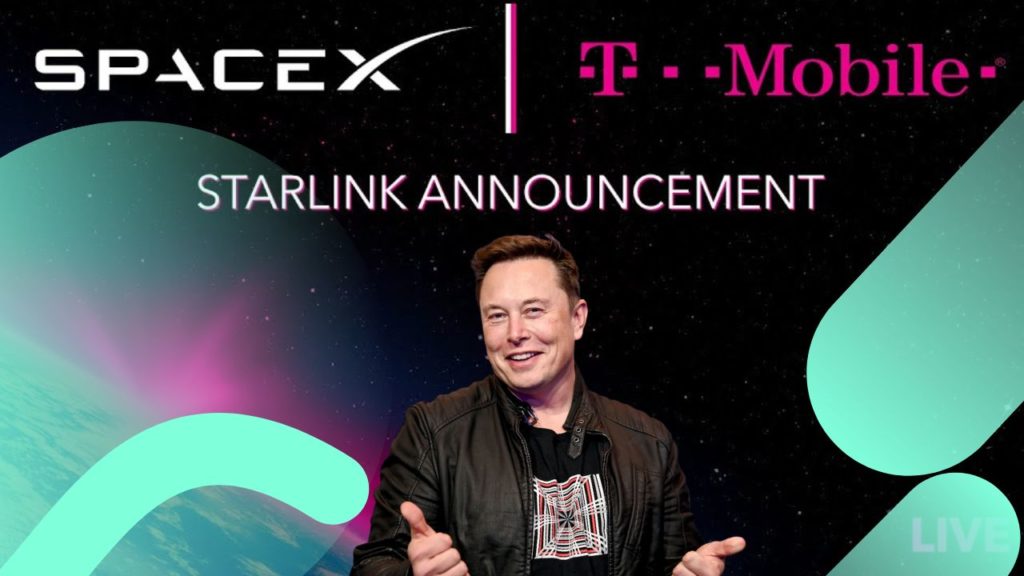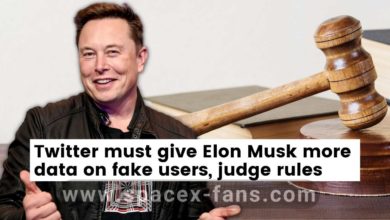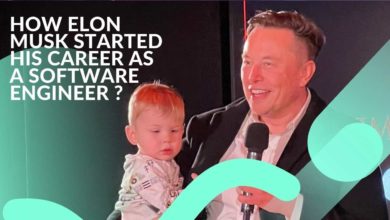
On Thursday, Elon Musk took the stage with Mike Seifert, the CEO of T-Mobile, to make the announcement that SpaceX will be partnering with the carrier to completely eliminate cellular dead zones. The companies claim that Starlink’s next-generation satellite, which is scheduled to launch in the following year, will be able to communicate directly with phones. This will make it possible to send text messages, make calls, and possibly broadcast video even when there are no cell towers in the immediate vicinity. In addition, Musk stated that all of this is achievable with the phones that people use now, and that there is no requirement for them to acquire any more hardware in order to do so.
It is a daring move on the part of the carrier to make this statement, given that neither Verizon nor AT&T have anything comparable. However, SpaceX and T-Mobile aren’t the only firms looking into the possibility of utilising satellites to interact directly with mobile phones by making use of the current cellular spectrum. Other companies include Sprint and Verizon. years upon years A firm known as AST SpaceMobile made the claim that it will be able to provide internet to phones from space, while another company known as Lynk Global has already demonstrated that it can utilise its satellite “cell towers” to allow normal phones to send text messages. It is easy to assume that these firms would be frightened that two giants were now trying to play a similar game; however, it turns out that this is not at all the case. Despite this, it is simple to believe that these companies would be afraid. It appears that they are in a good mood.
Who are some of SpaceX and T-competitors Mobile’s in the race to connect satellites to mobile phones?
In an interview with the edge, Lynk’s CEO, Charles Miller, made the following statement. Today, we were bombarded with calls from various carriers saying things like, “Help us!”
In the beginning of this year, Lynk successfully launched its first commercial satellite, which was accomplished by using a SpaceX Falcon 9 rocket.
picture: link
The primary objective of Lynk is comparable to that of SpaceX: the company is forming partnerships with a variety of carriers located all over the world in order to provide its customers with the ability to send text messages through the use of a network of satellites that is currently being assembled. Miller’s presentation, much like the one given by T-Mobile, placed a particular emphasis on the significance of technology in times of crisis and natural catastrophes, such as when storms, wildfires, floods, or earthquakes have the potential to destroy traditional mobile network infrastructure. “The key is adaptability. It is an immediate backup that may be used by any person on the planet. Even if the cell towers are out of service, your phones can still make and receive calls. “This will prevent many deaths.”
Miller is quite comparable to Sifte Stadium and Musk, but he doesn’t appear to be overly concerned about competing in the same market as they do. He attributes some of his self-assurance to the fact that Lynk was an early market leader; specifically, he asserts that he was the first person to send a text message from space to an unmodified mobile phone in early 2020. “We anticipate that there will be other major corporations joining the fray. They have a very long time ahead of them. He remarked that they are several years behind us. “We’ll be like, ‘Wow! Make everyone aware that this particular technology has been rendered obsolete. And when we begin implementing it at the end of this year, people are going to be saying, “I want it. They won’t want to wait for it for years if they can help it.
There are varying degrees of connection that are promised by Lynk, SpaceX, and AST.
This opinion was mirrored by Scott Wisniewski, who serves as the executive vice president and director of strategy at AST. Actually, our CEO is active on Twitter. According to what he had to say, “we are glad that they are focused on this really enormous market and this really big demand.” And it was reassuring to hear individuals say things like technology is working for them,” he added. Additionally, he forecast that the satellite-to-phone communications sector will most likely not emerge victorious in all of its competitions. According to our analysis, there will be a significant number of successful participants in the market as a whole.
It’s possible that T-Mobile has understated the scope of the AST service in their announcements. According to Seifert, he has high expectations that T-Mobile will one day be able to transport data via SpaceX satellites, whereas the primary objective of AST is to manage 4G and 5G networks. It is more important to her that people be able to send texts and make phone calls from remote regions, but she is banking that the concept of internet will be more appealing. “We are all well aware that there is a possibility that users’ phones would lose service often or that coverage may be spotty. And this was a point that was brought up by T-Mobile. According to Wisniewski, our method is quite appealing when viewed in light of this consideration.
Whereas SpaceX and T-plan Mobile’s is mostly restricted to the United States of America and its territories, the wireless spectrum that SpaceX uses for its service is owned and operated by other companies and agencies internationally; consequently, additional deals are required to operate anywhere outside of the United States of America. United and Lynk aspire to have an impact on a worldwide scale. AST secured an investment and an exclusive agreement to work together for the next five years with Vodafone, one of the major mobile service providers in the world. In addition, AST got investment from Rakuten, a mobile firm based in Japan. Miller claims that Lynk is now testing its service in ten countries “as we speak,” and that the company is able to make it accessible in dozens of more nations.
According to them, even the timing of the statement made by T-Mobile and SpaceX works out well for AST and Lynk. The first company is getting ready to launch an experimental satellite in a few weeks (with five more planned for 2023), while the second company is getting ready to start its commercial service with 14 different network operators by the end of the year. If there was ever a period when customers might be expected to show a high level of interest in precisely what it is that you are working on, it is likely that you are on the point of taking a significant initial step.
How Apple and the speculations around the iPhone 14 fit into this conundrum
However, Tim Farrar, an analyst at Telecom, Media and Finance Associates, a research and consultancy organisation specialising in satellites and communications, argues that T-timing Mobile’s may be due to another large rival set to join the market — a competition that might have AST advantages. The companies SpaceX and Lynk do not. “The problem will be what will happen next week with Apple,” he added, alluding to claims that the future iPhone may be able to interact with the Globalstar satellite network for emergency purposes. “The problem will be what will happen with Apple next week,” he said.
According to him, users of the iPhone might get this function very soon, and it could come in a version that supports many worldwide languages right from the beginning. “If Apple is going to announce something next week, I think it will most likely be something that is ready to go as soon as the phone is available. Because if they collaborate with Globalstar, Globalstar already has 24 satellites in space that are operational, and you are able to speak with them. In addition, Globalstar possesses licences from the FCC as well as many more from other foreign governments.
This very final point is of the utmost significance. According to Farrar, all that is required of Apple in order to remove itself from competition is to go through the “easy and well-defined” procedure of obtaining a licence for the necessary equipment from the FCC. It is not so simple for other firms, like SpaceX, who wish to communicate from space using spectrum that is licenced by cellular providers; this is one of such companies. Throughout the course of history, satellites made use of the spectrum that was reserved for satellites, while cell towers made use of the terrestrial spectrum. However, according to Farrar, the satellite-to-cell technology combines the two in a manner that the regulations do not yet permit. The Federal Communications Commission is going to have to make a significant regulatory shift. And it is something that they have been considering for the past two years but have not really developed a solution for.”
It is possible that competitors of T-Mobile may try to find a means to stop SpaceX from making use of the carrier’s spectrum, which could make issues much more complicated. According to Farrar, there will be a great deal of contention around the utilisation of terrestrial spectrum on the satellite. “already there have been questions raised over the Intervention.” It was brought up while AT&T and AST were negotiating a partnership so that AST could test out AT&T’s technology. None of the big wireless carriers would want it if their other companies’ competitors were to benefit from the advantage. There is no question that individuals will voice their opposition to any application that makes use of T-spectrum Mobile’s on satellites. There will be a need for a decision to be made by the FCC, which might not be reached very fast.
Every form of communication is organised in some way, and organisation is a process in and of itself. — Scott Wisniewski
In point of fact, Miller refused to discuss Spectrum at all, claiming that Link had a “open problem” with the service. According to Wisniewski, one of AST’s strategies for addressing spectrum challenges is to collaborate with carriers in order to secure permission from regulators. In addition to this, he stated that the nature of delivering the service in locations where it is not now offered may make things somewhat simpler. When there are no towers in the area, we share spectrum with mobile carriers on a non-interference basis.
According to Wisniewski, even though the AST has regulatory permission for commercial operation in seven different nations, the FCC is the only organisation that has sanctioned it. Test its satellite In order to test how well the Service works in the United States, we will deliver it there.
They don’t even anticipate to begin testing their service until the end of the next year, so their plans are quite a ways off. This gives the firms time to attempt to sort things out with the relevant authorities and gives SpaceX and T-Mobile some breathing room.
If one firm is able to get into a phone that is connected to satellite networks, this will likely be beneficial to all of the other companies. For instance, if Tim Cook were to announce on stage on September 7 that the iPhone 14 had the capability to transmit urgent messages via satellite, then a great number of individuals who do not own iPhones would experience intense feelings of envy very quickly. This might put further pressure on the FCC to approve the use of satellite technology in phones by telecommunications providers and their satellite communication partners. And if T-Mobile is the owner, you can bet that AT&T and Verizon will come calling at some point. (Farrar feels that other phone manufacturers who are not as strong as Apple or Samsung will have a hard time giving a comparable capability – carriers might fight it off by saying that their phones should only use the carrier’s satellite capabilities instead.)
Although it takes a somewhat different shape, Verizon already has an arrangement in place to facilitate satellite communications. It is a cooperation with Amazon’s Kuiper Project, which has the goal of developing a satellite constellation in a manner comparable to that of SpaceX. However, rather than establishing a direct link between the satellite and the phone, Verizon’s strategy is to feed remote cell towers with satellite service so that they do not require fibre or cable to be laid on them. Seifert stated that T-Mobile was open to the potential of doing something similar with SpaceX during the event that took place on Thursday.
There was no response from either Verizon or Amazon to the edge.
He wanted a remark on whether or not they would change their plans in light of the announcement that T-Mobile and SpaceX had made.
When it comes to this specific market, neither AST nor Lynk is especially interested in having other companies as competitors. Miller explained that since your phone is already connected to a satellite network, there is no need to construct remote cell towers.
From satellite to mobile phone, Elon Musk pulled the cat out of the bag.
At this juncture, there is only one thing that can be said with absolute certainty: T-Mobile and SpaceX have let the proverbial genie out of the bottle. They have made it abundantly clear that in the near future, your phone will be able to establish a connection to satellites. This will make it possible for you to maintain at least a minimal level of connectivity even in locations that have historically been devoid of any kind of human habitation whatsoever.
There are a number of different directions that things could go from here. AST tests could demonstrate that, yes, it is possible to really send relatively fast internet to phones from space, which would elevate what customers want to a higher level than what T-Mobile and SpaceX have set as their is-it standard. Or, it’s possible that regulators may suddenly sort things out and open the door for Lynk to capitalise on the situation before T-Mobile emerges from beta. And of course, there is always the risk that everyone may end up in a major regulatory tangle, allowing Apple to come in and do their own thing with a completely different sort of technology. This is a possibility that exists at all times.
Whatever the outcome may be, people are now aware that it is feasible for the phones they are already carrying around in their pockets to communicate with satellites. As Miller pointed out, now that I have seen it and am aware that the technology will be available in the near future, I want it — regardless of how many satellites my phone will need to communicate with.




